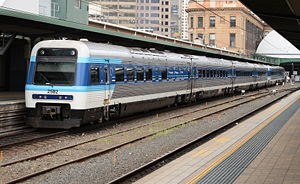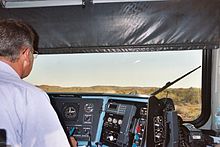- CountryLink Xplorer
-
Xplorer 
Countrylink Xplorer 2502 at Sydney Central.In service 1992 – present Manufacturer ABB Number built 23 cars Formation 2–5 car Operator RailCorp as the product group CountryLink Specifications Car length 25.250 m (82 ft 10 in) Width 2.921 m (9 ft 7 in) Height 4.11 m (13 ft 6 in) Maximum speed 145 km/h (in service); 160 km/h (design maximum) Weight 57 tonnes (56 long tons; 63 short tons) Engine(s) Cummins KTA19 (one per car) Power output 352 kW (472 hp) per car Transmission Voith Turbo T311r KB260 Gauge 1,435 mm (4 ft 8 1⁄2 in) The Xplorer is a Diesel Multiple Unit train used on country passenger rail services in New South Wales, Australia. It is one of two types of passenger rollingstock used by CountryLink, the government owned operator of country trains (the other type being the XPT). The Xplorer trains entered service in 1993, and are externally identical to CityRail's Endeavour railcars. All 23 carriages were built by ABB Transportation in Victoria, Australia.
Contents
History
In the early 1990s the Coalition NSW State Government was placed under considerable pressure from National Party members of parliament to reintroduce passenger rail services over the Main North and North- West routes to Armidale and Moree respectively.[1] Services over these lines had been withdrawn after the Booz-Allen Hamilton report into the State Rail Authority in 1989 which recommended the rationalisation of country passenger train services and developing an all-XPT fleet. The government decided to reintroduce services over these lines, and soon after the decision was made to also introduce new trains to Canberra. Tenders were placed on 8 August 1990 for new 'Explorer' self propelled diesel railcars to service these three routes. An option for interurban cars for CityRail was also added (which would lead to the Endeavour cars). In early 1991, a contract was signed with ABB Transportation to construct 17 Explorer cars based upon the five-railcar set built by Comeng for the Australind service in Western Australia. In April 1992, the government announced that 14 2-car sets would be added on to the order for CityRail, these became known as the Endeavour cars. At this time, the name 'Explorer' was changed to Xplorer to better fit in with the marketing of the XPT.[2]
Service
These trains travel on four CountryLink daytime routes, two of which are daily and two of which are weekly. They operate from Sydney to the destination during the day, either returning on the same day or the next day. The following destinations from Sydney are the Xplorer's destinations:
- Canberra -via Goulburn, 2-3 services each way per day. Normally a 3 car Xplorer service, under certain circumstances the train will be a 4 cars.
- Armidale and Moree -via Werris Creek. This is usually a five car set that divides at Werris Creek, 2 cars proceeding to Moree via Narrabri and 3 cars proceeding to Armidale via Tamworth daily. Sometimes this has been extended to a seven car set with 4 proceeding to Armidale and 3 proceeding to Moree or with merely 4 cars proceeding to Armidale or 3 cars proceeding to Moree with the normal number of cars retained for the other destination
- Griffith -via Goulburn and Junee. This train divides from the Canberra Xplorer service at Goulburn on Saturdays only, and heads to Griffith via the Main Southern railway line, New South Wales, the Hay railway line, New South Wales and the Yanco-Griffith railway line, New South Wales. The train stays overnight at Griffith and the next day heads back to Goulburn and rejoins the Canberra Xplorer service on the next day at Goulburn to make the return leg to Sydney although on occasions when either train has run late the trains make the journey to Sydney by themselves. This train is usually a two car Xplorer.
- Broken Hill -via Blue Mountains and Orange. Usually a 3 car set consisting of units which have additional protection to underfloor equipment and couplers due to hazards which are encountered on the line (such as kangaroos). Operates on Mondays heading to Broken Hill and heads back to Sydney the next day.
Carriages
Coding for the carriages are as follows:
- EA- First Class Driving Power Car: First Class seating, Buffet and Satellite Telephone.
- EB- Economy Class Intermediate Power Car: Economy Class seating and Toilet.
- EC- Economy Class Driving Power Car: Economy Class seating, Disabled toilet with baby change facilities, wheelchair space and booked Luggage space.
Carriage numbering is as follows:
- EA- #2501-#2508
- EB- #2511-#2517
- EC- #2521-#2528
EA #2508 and EC #2528 used to be Endeavour Railcars LE #2815 and TE #2865. They were rendered surplus when the Kiama Electrification took place, and were converted to Xplorers by Bombardier Transportation Dandenong, Victoria.
Each car is powered by a Cummins KTA 19R engine rated at 352 kW at 1800rpm, and an auxiliary engine.[3]
Refurbishment
Railcorp has released a tender regarding the refurbishment of the Xplorer and Endeavour railcars. The contract specifies: new seating, buffet upgrades, new carpets, toilet upgrades, extended booked luggage section, and more wheelchair spaces for the Xplorer Railcars. Included in the contract, is a provision of an Entertainment System being retrofitted onto the Xplorer units, however this is only pending a report and may not be installed in the refurbishment. All units will be repainted to the new corporate scheme of Cityrail and Countrylink. The refurbishment started in mid 2007 and concluded at the end of 2008.
Tenders closed on 20 December 2006, and there were three companies on the list:
- Bombardier Transportation
- United Group Rail
- Downer Rail
In the end, Bombardier Transportation won the contract.
See also
References
- ^ New Trains for Northern NSW. Sydney Morning Herald, 13 June 1990.
- ^ Hoyle, J. ABB Transportations Xplorer/Endeavour Railcars. Railway Digest, June 1995.
- ^ "CountryLink: XPLORER". RailCorp. http://www.countrylink.info/travelling_with_us/our_fleet/xplorer. Retrieved 2011-01-14.
Sydney and New South Wales Rail Rollingstock NSWGR steam locomotive X10 class • Z11 class • Z12 class • Z13 class • Z14 class • Z15 class • Z16 class • Z17 class • Z18 class • Z19 class • Z20 class • Z21 class • Z23 class • Z24 class • Z25 class • Z26 class • Z27 class (2705) • Z28 class • Z29 class • C30 class (3016) (3112) • C30T class • C32 class (3237) (3265) • C34 class • C35 class (3526) • C36 class (3642) • C38 class (3801) (3820) (3830) • D50 class • D53 class • D55 class • D57 class • D58 class • D59 class (5917) • AD60 classNSW Private Steam SMR10 classDiesel locomotive Electric locomotive Electric multiple unit U set • L, R, and S sets • K set • C set • V set • T & G sets (Tangara) • M set (Millennium) • H set (OSCARs) • A set (Waratah)Diesel railcar Rail transport in New South Wales • Rail rollingstock in New South Wales • CityRail fleet • CountryLink Categories:- CountryLink
- Diesel multiple units of Australia
- ABB multiple units
Wikimedia Foundation. 2010.

